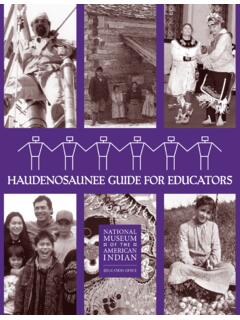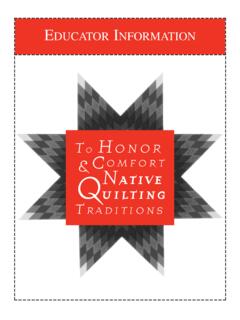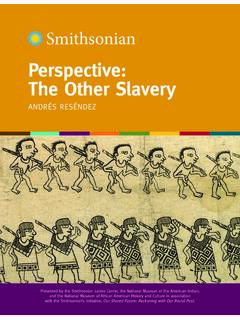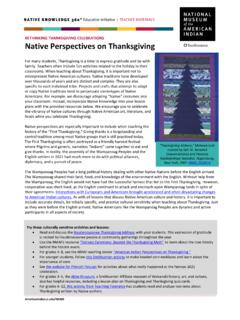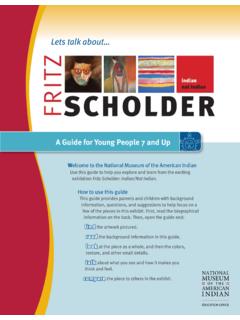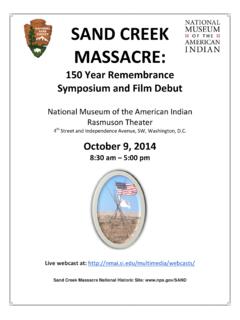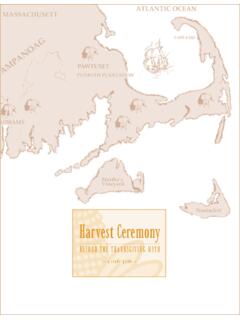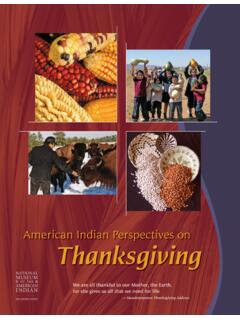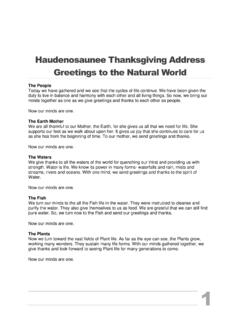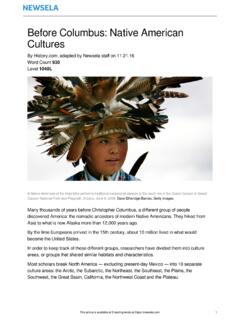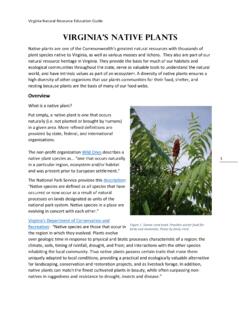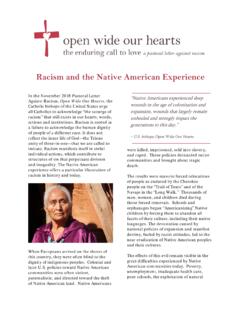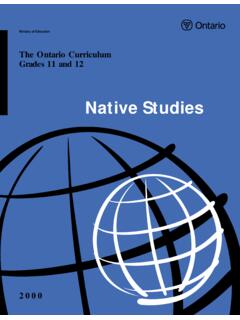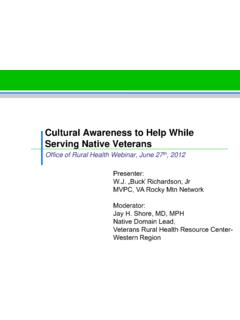Transcription of Native Knowledge 360˚ - Smithsonian Institution
1 Native Knowledge 360 Framework for Essential Understandings about American Indians A NATIONAL EDUCATION INITIATIVES mithsonianNational Museum of the American IndianVolkswagen Beetle named Vochol, decorated by Huichol (Wixaritari) artists using more than 2 million glass beads, 2006. Photograph by Alejandro Piedra Buena, courtesy of the Museo de Arte PopularNATIVE Knowledge 360 A National Education InitiativeTransforming Teaching and Learning about American Indians The Smithsonian s National Museum of the American Indian (NMAI) is joining with Native communities and educators nationally to help change the way American Indian histories, cultures, and contemporary lives are taught in K-12 classrooms. This long-term initiative, Native Knowledge 360 (NK360 ), provides educators and students with deeper and more comprehensive Knowledge and perspectives about Native Peoples, bringing the richness of the museum s collections, scholarship, and live programming, along with the diverse voices of Native experts and young people, directly into classrooms nationwide.
2 At the center of Native Knowledge 360 are Native people themselves. Currently, there is little evidence in classroom materials textbooks, curricula, or academic standards of important historical and contemporary events that include American Indian Knowledge and perspectives, and little or no integration of these events into the larger narratives of American and world history. The museum s collaborations with Native communities, teachers, scholars, and educational leaders are essential to the development of new resources for the classroom. Native Knowledge 360 is a platform for NMAI and Native Peoples to correct, broaden, and improve what is taught in the nation s schools and to provide model instructional materials and professional development for teachers.
3 It also serves as a stimulus for the national conversation on education for and about American Indians. To anchor this work, the Native Knowledge 360 home page features searchable lessons and resources for the classroom, information about programs and professional development opportunities for educators, and additional information about the NK360 initiative. Visit in collaboration with Native communities, education agencies and organizations, scholars, and teachers, the NMAI has developed classroom-ready resources that are diverse in content and format. Digital inquiry lessons, interactives, teaching posters, educational websites, and videos help teachers and students understand the complex and robust stories of Native America. Classroom resources feature primary and secondary sources, Native perspectives, images, and objects from the museum s collection.
4 Materials are accompanied by lesson plans for teachers and skills-based assessments for students. NK360 materials are designed to align with relevant standards, such as the Common Core State Standards (CCSS); the College, Career, and Civic Life (C3) Framework for social studies education; and STEM and arts-related standards. With these classroom resources, teachers can trust that they are providing their students with accurate, vetted, and culturally appropriate materials. In addition, the NMAI offers engaging professional-development programs for teachers in a variety of formats, such as residencies, institutes, workshops, digital learning, and conference presentations. Native Knowledge 360 resources and teacher training empower educators to confidently build meaningful classroom experiences that provide a more complete understanding of Native American histories, cultures, and contemporary lives.
5 13 NMAI ESSENTIAL UNDERSTANDING 1 AMERICAN INDIAN CULTURESThe 21st century classroom should include experiences that provide for the study of American Indian cultures and cultural is a result of human socialization. People acquire Knowledge and values by interacting with other people through common language, place, and community. In the Americas, there is vast cultural diversity among more than 2,000 tribal groups. Tribes have unique cultures and ways of life that span history from time immemorial to the present CONCEPTS There is no single American Indian culture or language. American Indians are both individuals and members of a tribal group. For millennia, American Indians have shaped and been shaped by their culture and environment. Elders in each generation teach the next generation their values, traditions, and beliefs through their own tribal languages, social practices, arts, music, ceremonies, and customs.
6 Kinship and extended family relationships have always been and continue to be essential in the shaping of American Indian cultures. American Indian cultures have always been dynamic and changing. Interactions with Europeans and Americans brought accelerated and often devastating changes to American Indian cultures. Native people continue to fight to maintain the integrity and viability of indigenous societies. American Indian history is one of cultural persistence, creative adaptation, renewal, and resilience. American Indians share many similarities with other indigenous people of the world, along with many Knowledge 360 : Framework for Essential Understandings about American IndiansNative Knowledge 360 : Framework for Essential Understandings about American Indians2(Left to right) O-o-be (Kiowa), 1895.
7 Fort Sill, Oklahoma. Photographer unknown, NMAI. Kwagiulth Flower by Richard Hunt (Kwak waka wakw), by Roger Whiteside, NMAI. Christopher Cote (Osage), 2008. Skiatook, Oklahoma. Photograph by Katherine Fogden (Mohawk), NMAINATIVE Knowledge 360 A National Education InitiativeFramework for Essential Understandings about American Indians Educators! The Smithsonian s National Museum of the American Indian (NMAI) invites you to consider content about American Indians from a more complete perspective. NMAI s Native Knowledge 360 (NK360 ): Essential Understandings about American Indians is a framework that allows you to see new possibilities for creating student learning experiences. Building on the ten themes of the National Council for the Social Studies national curriculum standards, NMAI s Essential Understandings reveal key concepts about the rich and diverse cultures, histories, and contemporary lives of Native Peoples.
8 These concepts reflect a multitude of untold stories about American Indians that can deepen and expand your teaching of history, geography, civics, economics, science, engineering, and other subject areas. NMAI collaborated with Native communities, national and state education agencies, educators, and others to develop these Essential Understandings. They serve as the foundation for our museum s educational work. We also share them with teachers, curriculum developers, other museums, state and federal agencies, and education organizations to promote more expansive and informed thinking about Native American histories, cultures, and contemporary lives. We encourage state and local educators to work with Native Peoples in their areas to make the Essential Understandings more specific and relevant to their regions and to design curricula and materials that address local standards.
9 Teachers know that it is impossible to teach about the Americas histories, governments, cultures, environments, societies, and contemporary issues without teaching about Native Americans. Instead of the same old lessons about ancient American Indian food, clothing, and shelter, we invite you to explore the resources available to educators through NK360 . Visit and consider how you can expand your students Knowledge and understanding of the contributions and experiences of Native Peoples of the Western Hemisphere. Resources from Native Knowledge 360 demonstrate what NMAI s Essential Understandings look like in acknowledgement: The NMAI thanks the Montana and South Dakota Offices of Indian Education, who first established Essential Understandings for their respective states and have partnered with the NMAI to create its national ESSENTIAL UNDERSTANDING 3 PEOPLE, PLACES, AND ENVIRONMENTSThe 21st century classroom should include experiences that provide for the study of American Indian people, places, and environments.
10 For thousands of years, indigenous people have studied, managed, honored, and thrived in their homelands. These foundations continue to influence American Indian relationships and interactions with the land CONCEPTS The story of American Indians in the Western Hemisphere is intricately intertwined with places and environments. Native Knowledge systems resulted from long-term occupation of tribal homelands, and observation and interaction with places. American Indians understood and valued the relationship between local environments and cultural traditions, and recognized that human beings are part of the environment. Long before their contact with Europeans, indigenous people populated the Americas and were successful stewards and managers of the land, from the Arctic Circle to Tierra del Fuego.
